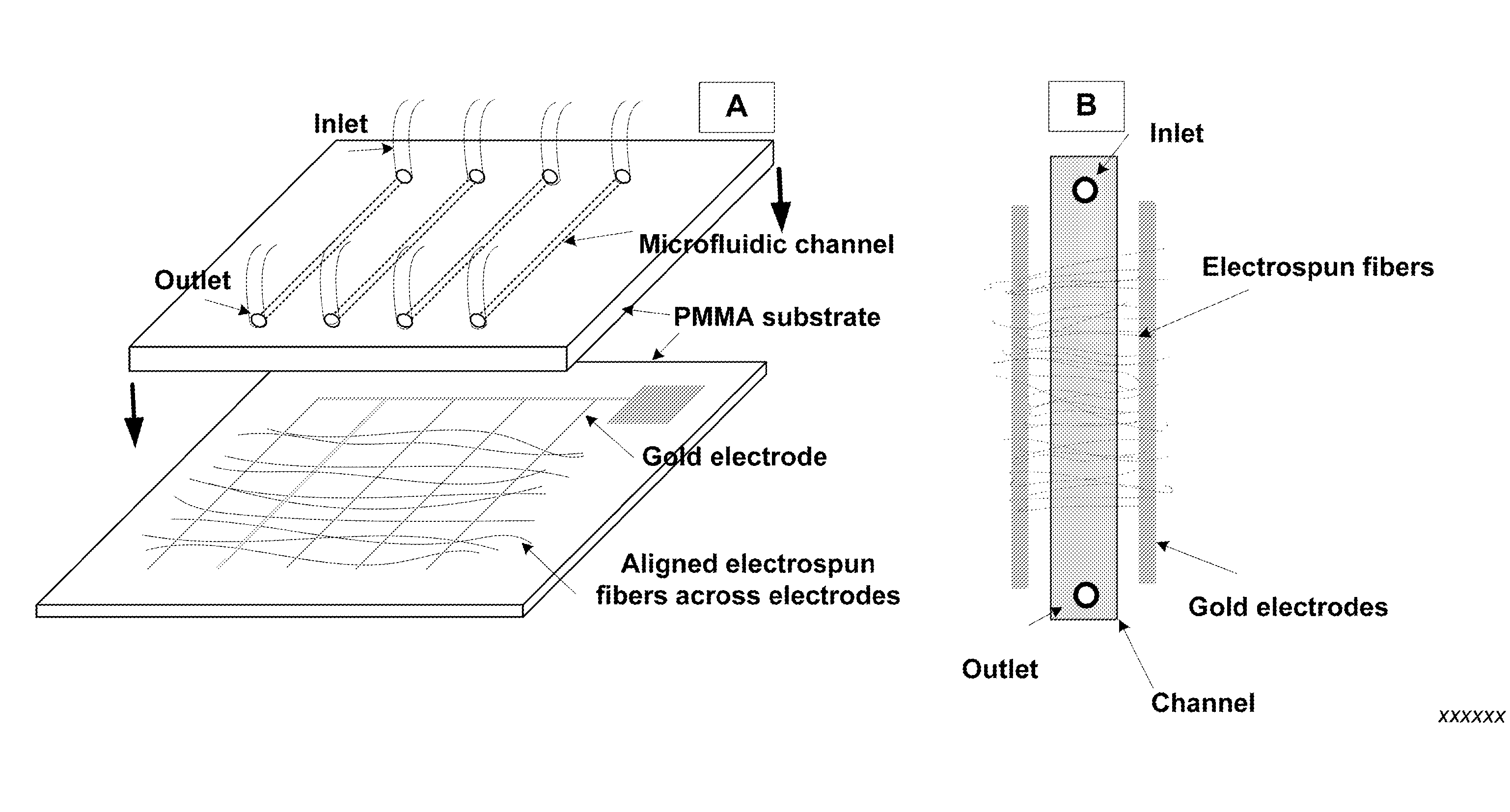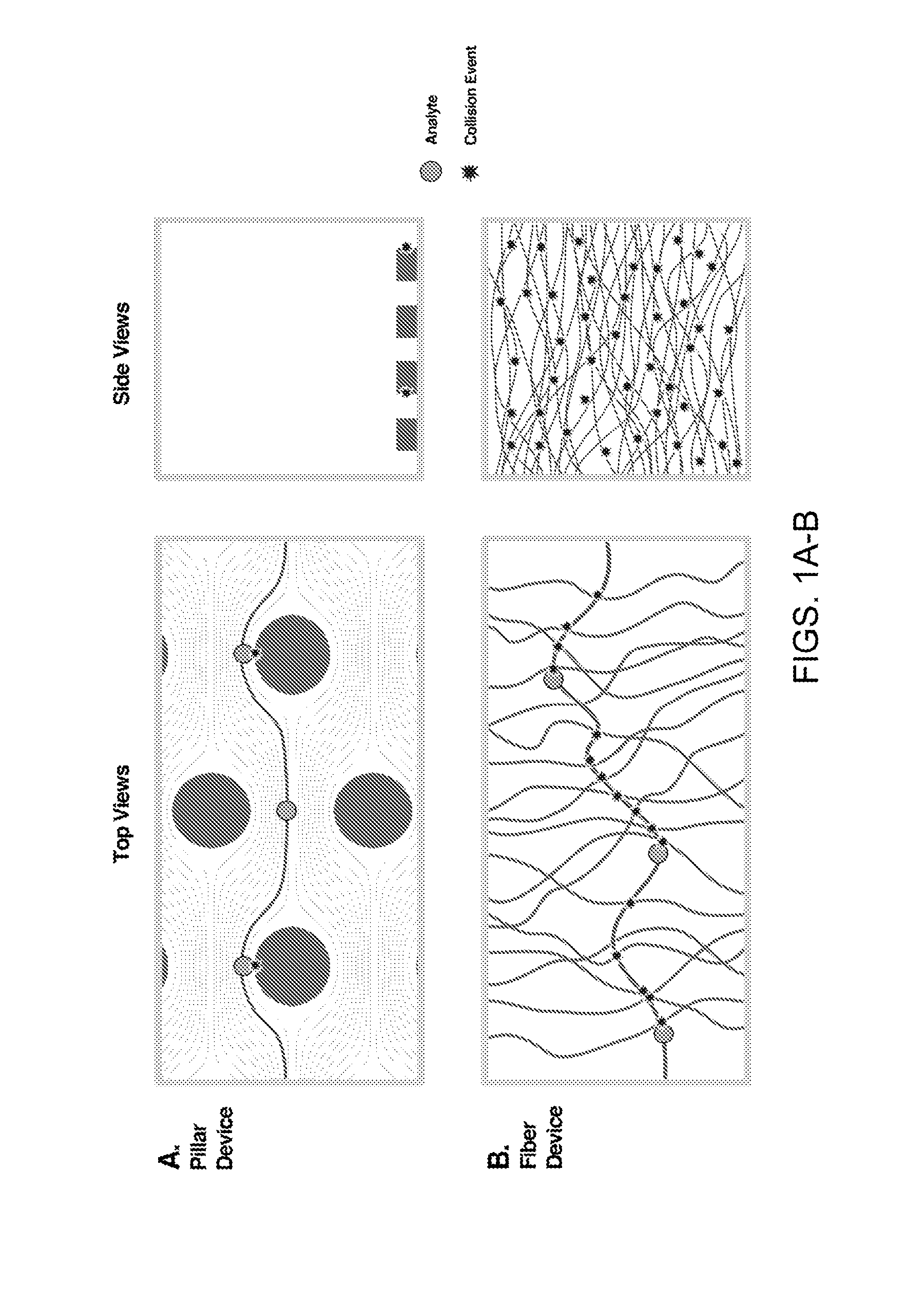Biofunctional nanofibers for analyte separation in microchannels
a microchannel and biofunctional technology, applied in the direction of diaphragms, fluid speed measurement, chemical vapor deposition coating, etc., can solve the problem of limited diffusion transport and other problems
- Summary
- Abstract
- Description
- Claims
- Application Information
AI Technical Summary
Benefits of technology
Problems solved by technology
Method used
Image
Examples
example 1
6.1. Example 1
Electrospun Nanofibers for Microfluidic Analytical Systems
[0222]In this example, poly(vinyl alcohol) (PVA) blend nanofibers formulated to create variations in fiber surface chemistry were electrospun to form patterns around gold microelectrodes on a poly(methyl methacrylate) (PMMA) chip surface. These nanofiber patterns were integrated into polymer-based microfluidic channels to create a functionalized microfluidic system with potential applications in bioanalysis. Spinning conditions and microelectrodes were optimized to enable an alignment of the nanofibers across the microfluidic channel. X-ray photoelectron spectroscopy (XPS) and Fourier transform infrared spectroscopy (FTIR) were used to characterize the electrospun fibers and the results demonstrated that functional nanofibers were successfully spun from the polymers. Nanofibers spun into the microfluidic channel maintained their morphologies during fluid flow at linear velocities of 3.4 and 13.6 mm / s Nanofibers ...
example 2
6.2. Example 2
Demonstration of Biosensing by Nanofibers in Microfluidic Channels
6.2.1. Background
[0257]Food- and environmental safety, biosecurity and clinical diagnostics all rely on the ability to detect pathogens, toxins, or clinical markers at low concentrations, accurately and reliably. Simple, over-the-counter biosensors have been developed for some particular cases: the home pregnancy test, and the glucometer for diabetic patients. However, for most detection challenges that we face as a society lengthy and expensive laboratory procedures are required. The costs of the tests and time until results are obtained are insurmountable obstacles. For safety and security-related tests and for diagnostics in resource-limited settings rapid, inexpensive and easy to use tests can have a huge impact.
[0258]Over the last three decades, researchers have developed sensing technology that is capable of detecting single cells and even single molecules. However, their detection can only be acco...
example 3
6.3. Example 3
Nanofibers for Use in Microfluidic Channels in In Vitro Models for Cancer Cell Migration Studies and with Relevant Chemical and Biological Functionality for MicroTAS Systems
[0262]This example describes the development of nanofibers from materials compatible with microfluidic in vitro models for cancer cell migration studies and with relevant chemical and biological functionality for microTAS systems. Nanofibers can provide increased surface area and surface functionality patterned at specific locations within channels. Nanofibers have quantifiable and modifiable mechanical, chemical and biological properties that enhance the range of variables addressable in microfluidic devices.
6.3.1. Experimental Design
[0263]A range of fiber chemical, biological and physical properties has the properties necessary to serve as ECM for specific cell growth within a microfluidic in vitro model, and selectively capture components of a mixed analyte, immobilize proteins or antibodies, and...
PUM
| Property | Measurement | Unit |
|---|---|---|
| diameter | aaaaa | aaaaa |
| thickness | aaaaa | aaaaa |
| pH | aaaaa | aaaaa |
Abstract
Description
Claims
Application Information
 Login to View More
Login to View More - R&D
- Intellectual Property
- Life Sciences
- Materials
- Tech Scout
- Unparalleled Data Quality
- Higher Quality Content
- 60% Fewer Hallucinations
Browse by: Latest US Patents, China's latest patents, Technical Efficacy Thesaurus, Application Domain, Technology Topic, Popular Technical Reports.
© 2025 PatSnap. All rights reserved.Legal|Privacy policy|Modern Slavery Act Transparency Statement|Sitemap|About US| Contact US: help@patsnap.com



